Disney Illusion Island is a non-linear platformer that sends Disney’s iconic mascots on a lavishly-animated adventure to save a magic island from destruction. The plot kicks off when Mickey, Minnie, Donald, and Goofy are lured to an island named Monoth by treasure maps promising a picnic reward. Instead of a picnic, the quartet find Toku, the leader of a race of rabbit-like creatures called the Hokun. Toku explains that the Hokun’s library has been robbed of three magic books. Unless the books are returned, Monoth will soon be destroyed. Impressed by the quartet’s heroic exploits on film, Toku sent the fake maps so he could recruit them to recover the books. I and up to three of my friends in local co-op choose our favorite character and set out into Monoth, traveling between its three biomes to track down the book thieves and save the Hokun from their doom.
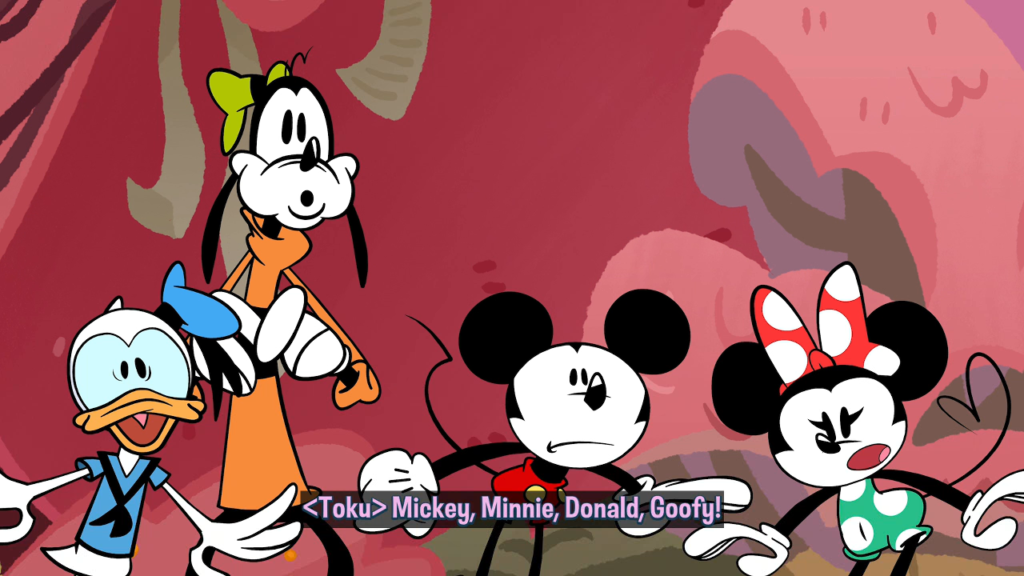
Perhaps unsurprisingly due to its source material and publisher, the character designs in Disney Illusion Island are excellent. Mickey, Minnie, Donald, and Goofy all have unique animations that give me some insight into their character.
Mickey and Minnie move with confidence and grace, befitting their status as the main stars and leaders of their group. Though they could easily share the same animations due to their near-identical appearances, enough care is put into their fine details to make them distinct. The volatile Donald stalks forward with his hands balled into fists, while the aloof Goofy lopes with casual obliviousness. Their hats are their most captivating features, hopping in time with their movements, always on the verge of flying away before returning to their owner’s heads by inexplicable cartoon gravity.
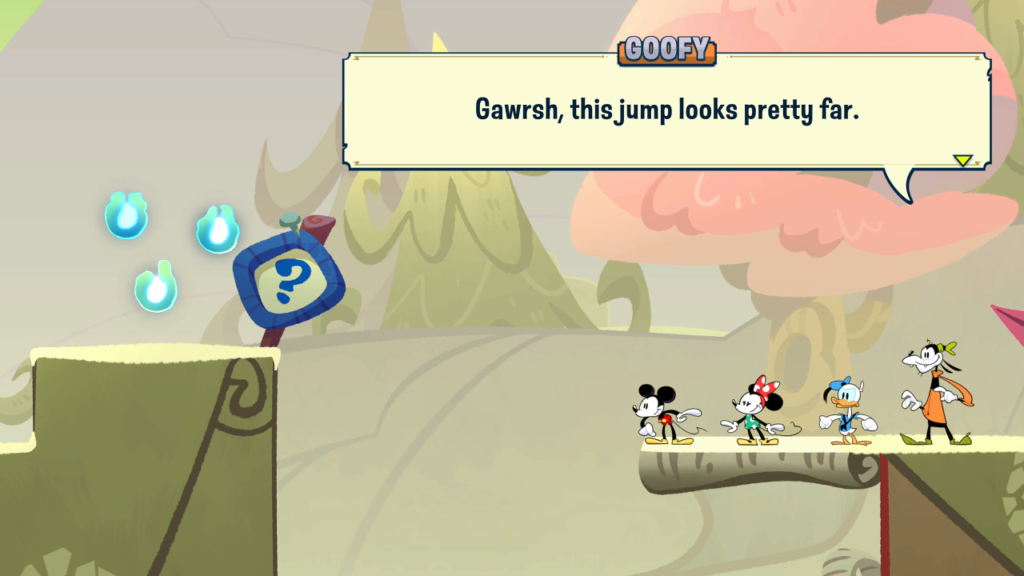
The characters’ animations become even more interesting as they receive their improved jumping abilities. Almost as soon as their adventure starts, the quartet find their path forward blocked by a gap that is too wide for them to jump. They find a solution from Mazzy, a friendly pink crocodile who loves creating devices and giving them away for free. It is his inventions which let the heroes fully explore Monoth.
Mickey and Minnie get the most straightforward new movement abilities. Mickey is bestowed with Mazzy’s fanciest gadgets, donning goggles and a jetpack to boost himself through the air and a pedal-powered helicopter to hover in wind columns or slow his descent from great heights. Minnie is a mixed bag of whimsy and third-wave-feminist power, boosting through the air with a giant paper airplane or a parasol, but also surmounting obstacles with a carabiner and a climber’s axe that casts her in the adventuring spirit of Crystal Dynamics’ Lara Croft.
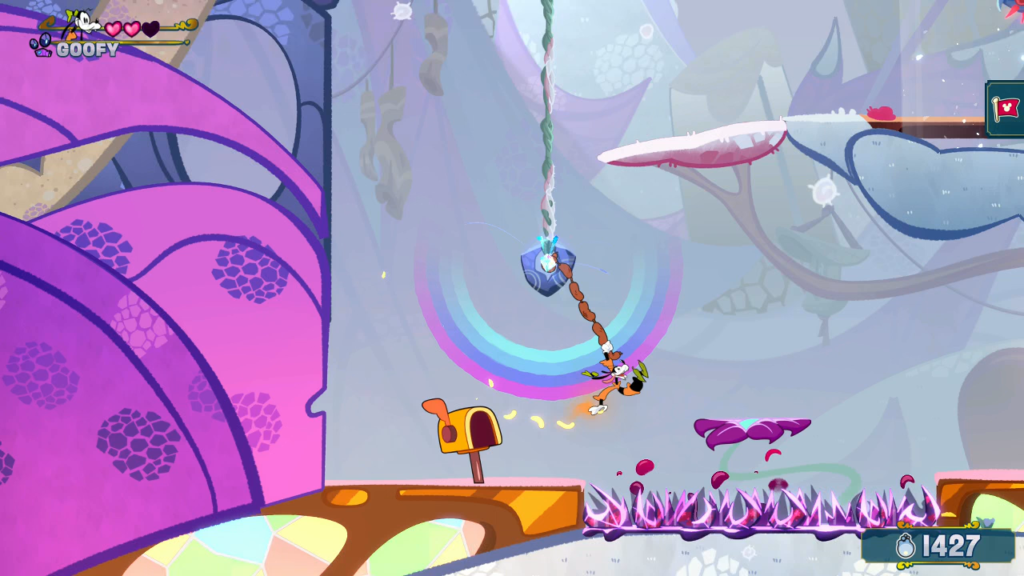
Instead of gadgets, Mazzy gifts Goofy with food. A massive spicy pepper gives him a midair boost. He crashes through fragile floors on a gigantic donut. To hover, he squirts a colossal mustard bottle, point-down to the ground. To swing from grapple points, he uses sausage links. Since Goofy’s brand of humor is built around slapstick absurdism, it all makes perfect sense in his own weird context. Goofy is my favorite character for this reason.
Donald is always bestowed his gadgets last, and thus gets stuck with something Mazzy slaps together from leftover trash. To boost his jump, he straddles a firework. To wall jump, he uses a plunger. To swim underwater, he uses a broken fan and a bent straw. His use of Mazzy’s “gadgets” is accompanied by the suggestion he is being hurt or humiliated in some way. Since this Donald is selfish and short-tempered, this is his karmic comeuppance, and I don’t mind in the slightest.
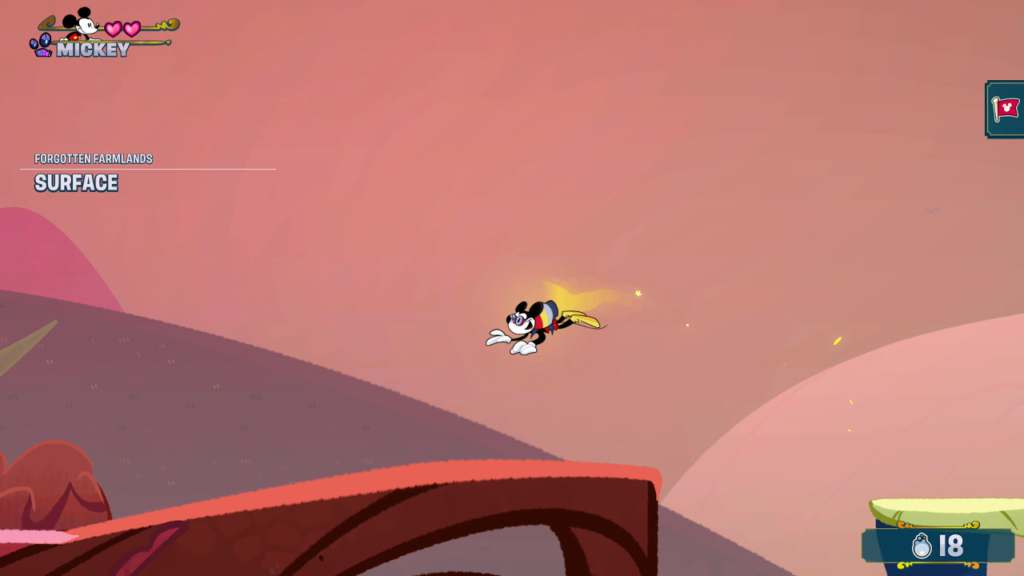
That the characters have this much disparity in their animations and even in their physical size makes it all the more remarkable that they feel identical to play. Even after spending several hours with each of them, I can discern no difference in how they function. There is no obvious advantage or disadvantage to playing as Mickey or Goofy, despite the radical differences in their appearances. This ensures if one or more of my friends play with me, nobody gets an unfair edge. When I’m playing by myself, I can choose who I want without worrying about suboptimal statistics.
In every way I examine them, the character designs and animations in Disney Illusion Island are stellar.

I wish I could extend the same level of admiration to the levels. Monoth nominally contains three unique biomes, each containing multiple regions. These are all connected in a seamless map that stretches in every direction from the starting point near the Hokun’s library.
My disappointment is not caused by Monoth’s mechanical details. When I think of individual regions, I recollect features which make them unique and fun to traverse. Crater’s Bay is filled with constellation-like platforms that do not take form until the player character touches nearby clouds of stardust. The Monoth Official Postal Service, or MOPS, has modular hallways that can be rotated in and out with buttons placed at key locations. The Forgotten Farmlands are home to plants which either bounce the player character into the air when they are touched, or try to swallow them whole when they are trod upon.

My disappointment stems from how visually indistinct Monoth appears in its totality. Everywhere I look, I see rounded edges. I have to really stop and squint at a scene to recognize that the floors around the Library are made from giant vellum scrolls, or that Downtown Gizmopolis has platforms made both from musical instruments and toothbrushes. The color palette is bland and uninteresting, making it more difficult to pick out each environment’s distinct features. The effort put into the player characters’ uniquely animated personalities are not reflected in the levels. Everything looks the same. Nothing stands out. Nothing is memorable. If the intent is to make the player characters pop even more against bland environments with washed out colors, then mission accomplished to disastrous effect.
The visually unmemorable environments are redeemed somewhat by how much fun they are to platform through. The quartet feel constrained when their adventure begins, stymied even by short jumps. By the time they’ve met Mazzy a few times and adopted most of his gadgets, this feeling shifts. After a few hours, few jumps go unaided by a wonderfully animated ability.
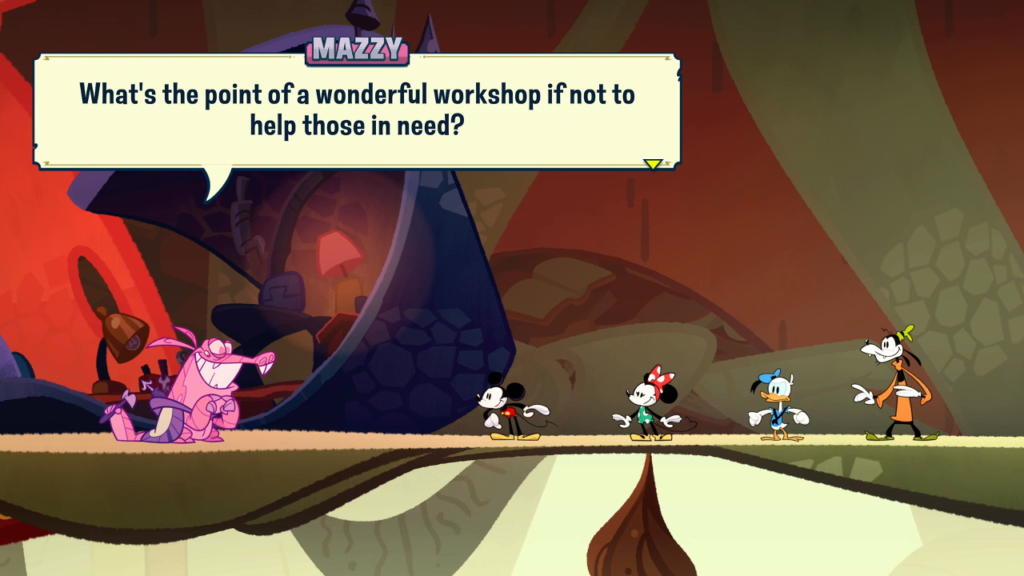
Most of Mazzy’s inventions provide improvements to movement that will be familiar to non-linear platforming veterans. By the end of their adventure, each player character can wall jump, swing, ground pound, float, and swim through Monoth’s environments. Yet something is missing from this traditional collection. Disney Illusion Island’s boldest choice is to exclude the classic double jump. Instead, Mickey, Minnie, Donald, and Goofy learn to boost jump.
At first glance, a boost jump appears to be a double jump. It is performed in midair and gives the player character the extra space they need to reach previously out-of-reach platforms. The difference is the boost jump adds only distance, not altitude. The result is transformative. High platforms remain out of reach, forcing the quartet to stay low to the ground until they can add some height. That ability comes from Mazzy’s wall jumping inventions. Once they obtain these complementary tools, any time the player character needs to reach a higher platform, they boost jump into a nearby wall to do it.
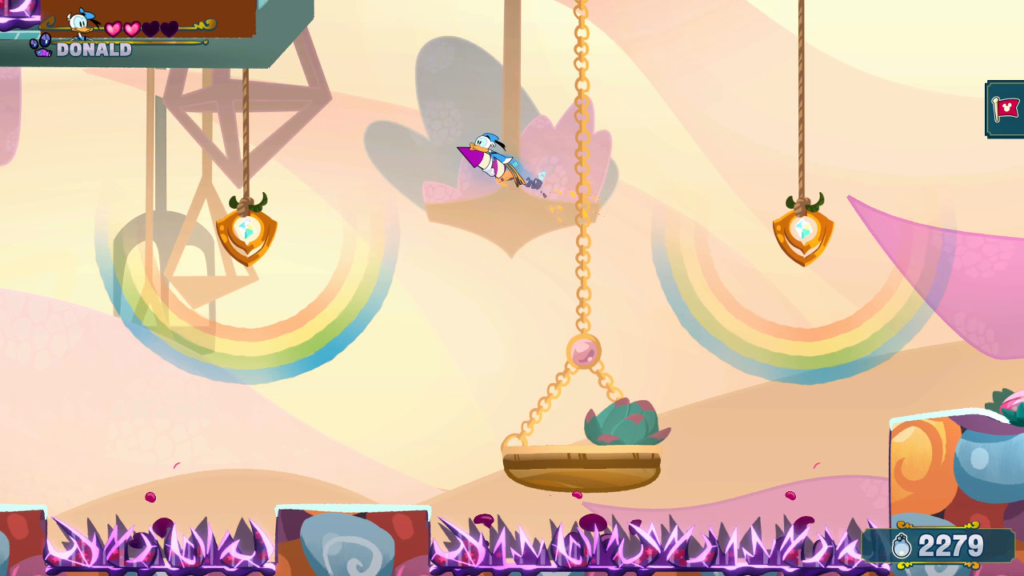
As abilities accumulate, the level design begins to weave them all together into a near-seamless flow. A boost jump leads to a wall jump, then to a swing from a grapple point, into another wall jump, and a final boost jump to reach the end of the line. Pedestrian behavior like walking and hopping becomes the exception and not the rule. In Disney Illusion Island’s best moments, I ascend into a zen state, weaving beautifully animated movement abilities into an effortless chain that recalls the design philosophy of Tony Hawk’s Pro Skater.
Another bold design choice that sets Disney Illusion Island apart from other non-linear platformers is it lacks any kind of combat system. There is no way to defeat the fauna that wander Monoth. Touching them in any way, even ground pounding onto their heads, only hurts the protagonists. It’s easy to suspect the shower of Disney corporate notes swirling from on high which led to this design decision, but it does help the experience feel unique in a crowded genre. The choice transforms enemies from sources of experience points and loot to a hostile and mobile aspect of the environment which adds more complications to the platforming layers.
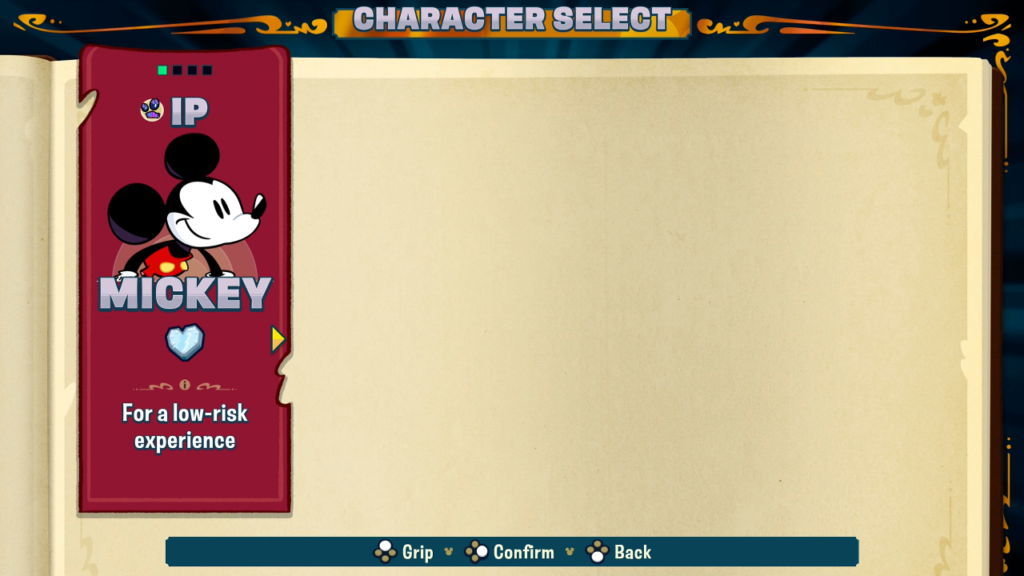
The lack of a combat system necessitates a different approach to difficulty levels. Instead of making enemies more resilient and deal more damage, I can choose how many hit points the player character possesses. My default choice is three hit points, but I can reduce them down to one if I choose, meaning a single mistake sends the player character back to the most recent of many generously-placed checkpoints. There is also an option to wrap the player character’s heart in iron, making them invulnerable to all damage. This is a great and thoughtful addition for younger players and families who will doubtless be drawn to Illusion Island by the Disney brand and find that it’s quite an involved platformer. I wouldn’t describe it as difficult, but with all my non-linear platforming experience, I did get my player character killed a few times in the course of their adventure. Novices may find themselves surprised by Monoth’s dangers.
The lack of a combat system does not preclude there being several boss fights. Instead of damaging bosses directly, the player characters overcome single-screen obstacle courses, putting all of their abilities to use activating buttons and switches which drop heavy objects onto boss’ heads. Encounters are further complicated by each boss’ screen-filling attacks and the obstacle courses themselves which transform multiple times as each fight progresses. The formula is rigidly followed for every boss, but the course layouts are all original and grow in complication as the player characters accumulate Mazzy’s inventions, so I barely notice.
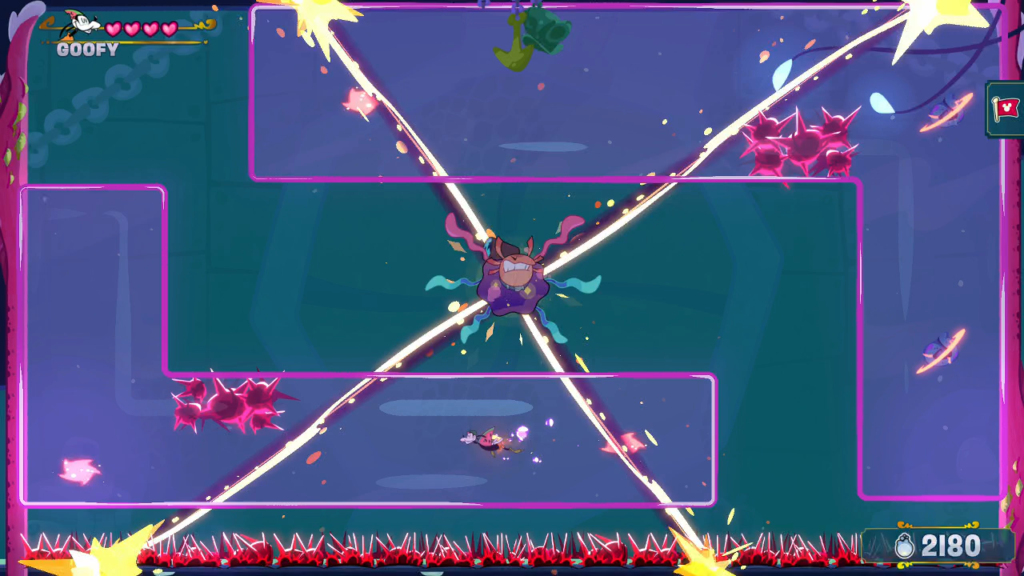
Where Disney Illusion Island feels traditional is its inclusion of collectables. Monoth is littered with objects for the quartet to gather. Glimts are the most important. Found in clusters of three across every corner of the island, gathering enough of these energy orbs expands the player character’s hit point meter by a single point. Tokuns and Mickey Memorabilia require more effort to reach, often placed in hidden spaces or beyond optional platforming challenges. They provide trivia about Mickey and his friends’ previous adventures and about the inhabitants of Monoth.
The last collectable category are Hidden Mickeys. An insider’s game at Disney theme parks is to find objects which have been arranged to resemble Mickey’s familiar three-circle silhouette. Monoth is likewise riddled with these objects, and much like the habits of real-life fans, the quartet pose for a selfie when they discover and activate one. Finding them all is the most involved and elusive activity, demanding slow exploration and careful examination of both foreground and background elements.
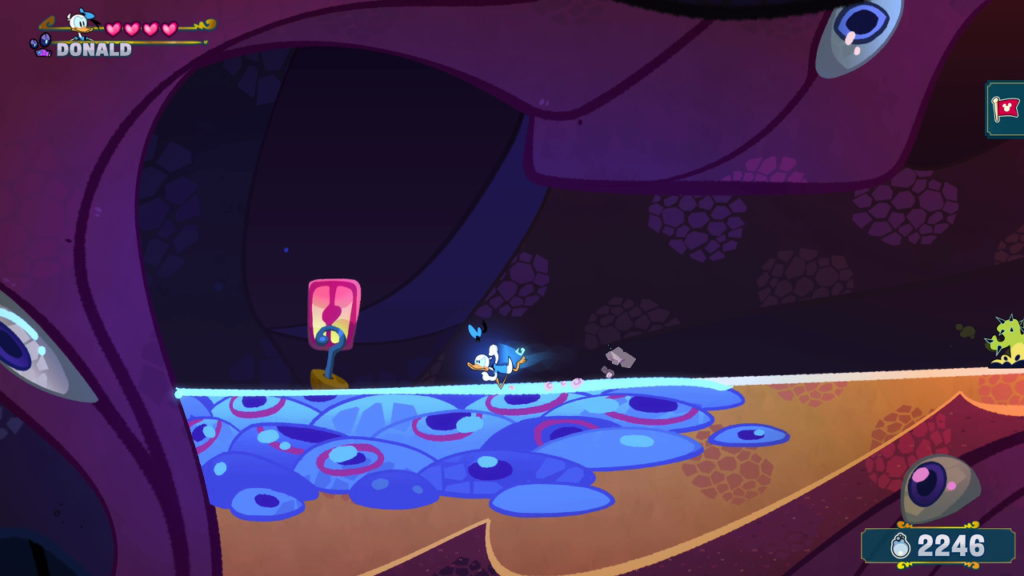
It is with these collectables that I must return to Monoth’s level design. Gathering all of them is a chore because of how each region is arranged. Non-linear platformers are often typified by environments filled with large, broad rooms that are interconnected by many intersecting passageways. Learning how all these areas are joined together and leveraging this knowledge to quickly cross the world is most of the fun of playing a non-linear platformer.
In another defiance of norms, Disney Illusion Island eschews large, broad, and interconnected rooms for long, winding, dissociated tunnels. Monoth’s three biomes are really only connected through the Library hub at its center. Each region twists and turns and will even sometimes loop back into itself, giving the impression of a sprawling map to explore. In actuality they are a straight shot to the boss encounter that protects one of the Hokun’s magic books. The result is a non-linear platformer that feels disconcertingly linear.
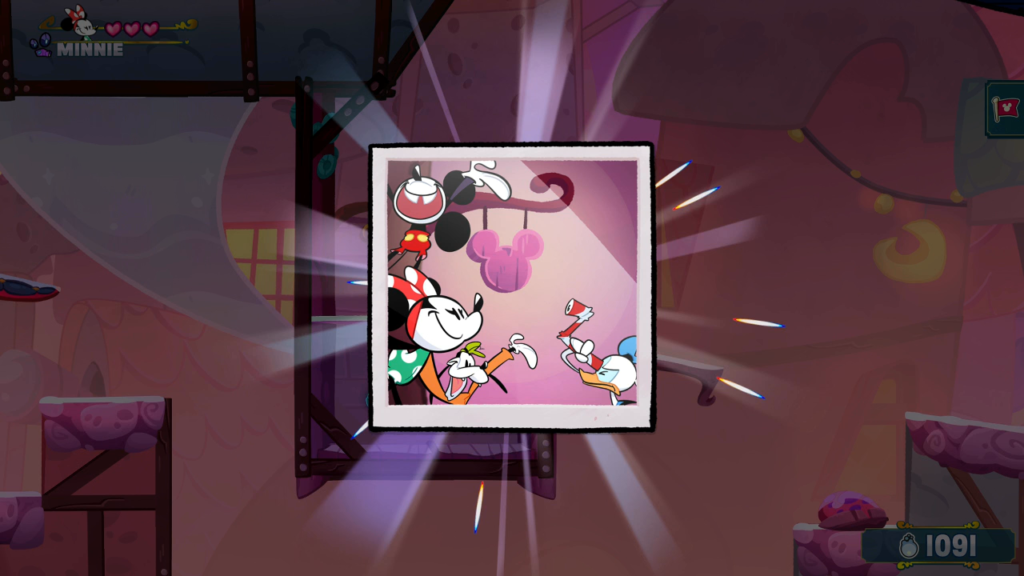
I believe the purpose of this tunnel syndrome is to encourage me to descend into that platforming flow state, chaining together boost jumps, wall jumps, grapple swings, and ground pounds in a hypnotizing display of animation and level design. This is a lot of fun when following the plot. When I return to a region to search for collectables I missed or were out of reach on the last visit, it becomes more like a chore. Since each region is really one long linear tunnel, I have to cover much more ground than is necessary to claim them all.
The obvious solution to this drudgery is to use fast travel to bypass as much space as possible. There is even a clever in-universe explanation for a checkpointing and fast travel system. The quartet pass dozens, if not hundreds of mailboxes as they travel through Monoth. If they run out of hit points, they are folded into an envelope and literally mailed to the last mailbox they passed to try again. These mailboxes also double as fast travel points. How fast travel is unlocked is where Disney Illusion Island makes its biggest blunder.
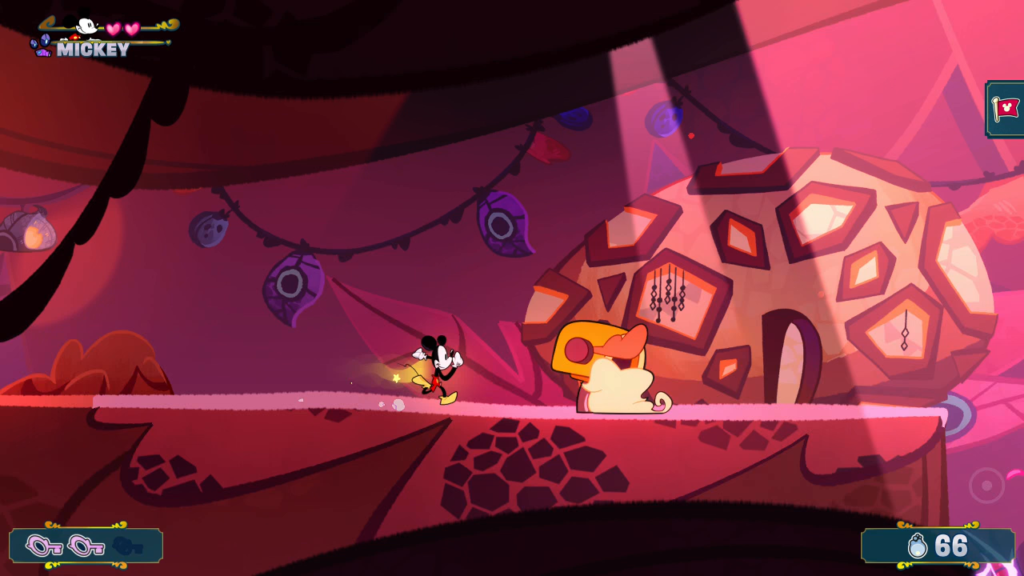
I happily follow the main plotline until the heroes have recovered all the Hokun’s magic books, still believing that fast travel will be made available to me if I continue with the story. When I try to return the books to the Library, I am presented with a large box containing a warning in bold text: “You will be unable to finish some content until the story is complete.” Somewhat bewildered to have reached the final boss and still having no access to fast travel, I decide that I am enjoying my experience enough to break away from the plot to gather the remaining collectables.
This is a mistake.
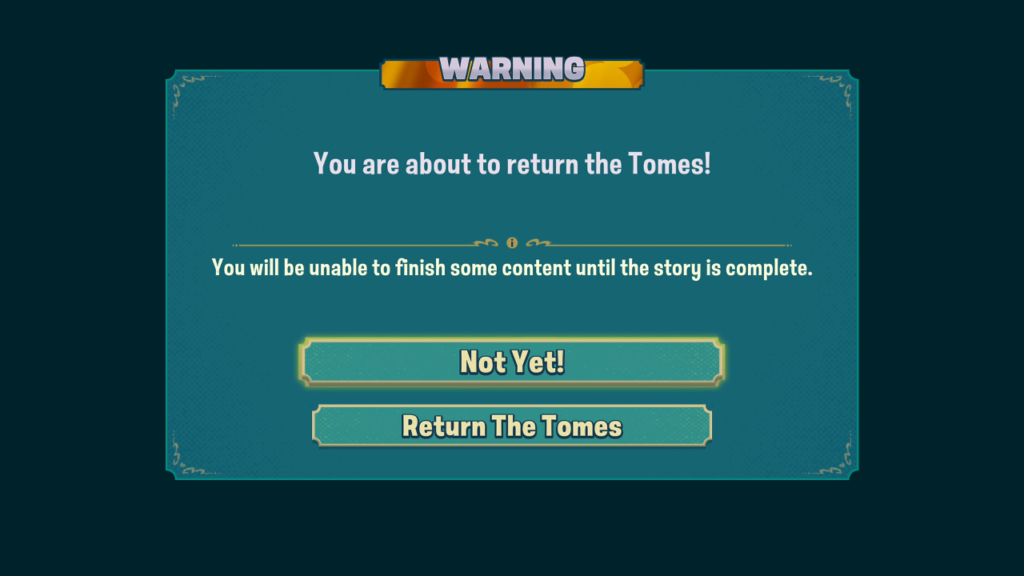
It is while retracing my steps through Monoth, gathering the remaining Glimts, Tokuns, Memorabilia, and Hidden Mickeys, that I can no longer overlook Monoth’s incredible linearity. I add at least three more hours to my playtime running through long tunnels again and again in search of the few remaining collectables, becoming more and more frustrated by how much space I am forced to tread and retread. Finally I uncover the last Hidden Mickey and return to the Library, relieved to turn in the books and challenge the final boss.
Instead of a final boss, turning in the books unlocks fast travel and the heroes are sent on another last minute trip around Monoth. Now with the ability to zip wherever I want at the cost of a short loading screen, the task is completed in less than ten minutes. Returning once more to the Library, I am presented with another bold-text warning: “You will be unable to finish some content until the story is complete (we mean it this time).” I am not proud to admit that the words “we mean it this time” made me curse loudly at a videogame for children and families. These warning screens are either a blunder in communication or a cruel prank on enthusiastic players. In either case, I strongly resent them.
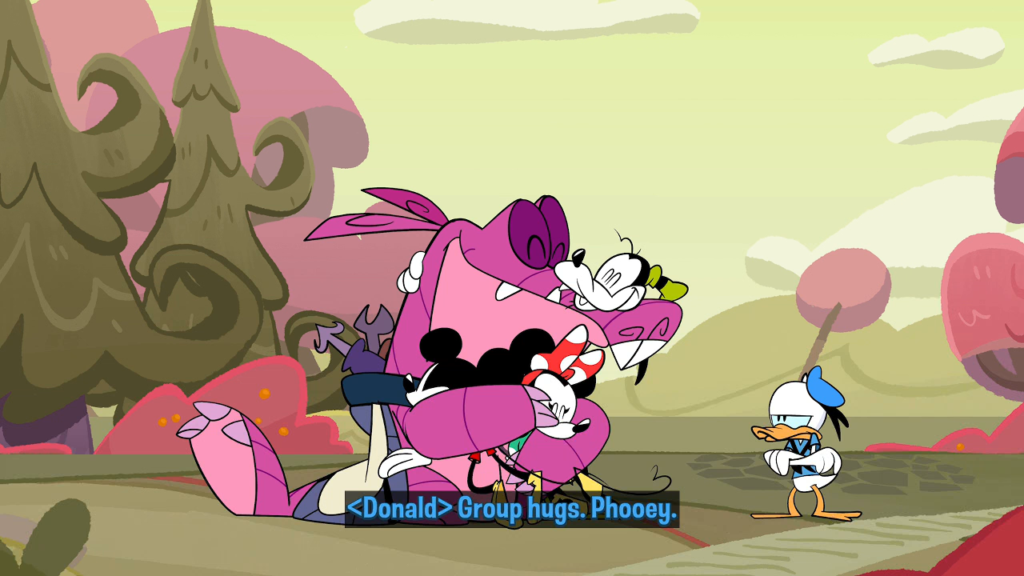
I try not to let these brief, misleading warnings ruin my opinion of Disney Illusion Island. I think it’s a wonderful platformer, even accounting for my criticisms of its level design. Due to its long, winding, and linear tunnels, it doesn’t quite have the spirit of a non-linear platformer. It’s a charming time nonetheless. The platforming is enjoyable, enhanced considerably by fantastic character designs and lavish animations. Just remember to ignore any warning signs thrown up in your path if you decide to seek out every collectable. They are the foundation of lies upon which Disney Illusion Island builds its potential downfall. Don’t make the same mistake I did, and I believe players of any age will have a grand time.